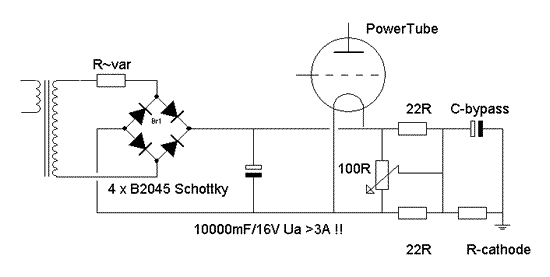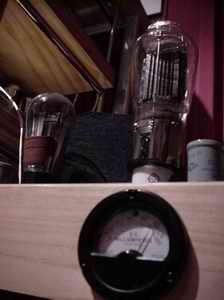Alesa Vaic AV325B "ref" mesh triode
The AV325B "ref" is by far the biggest triode I laid my hands on!
This is a real "powertriode" with its 75watts plate dissipation and
27watt RMS output... Ofcourse it has to be run hot to achieve these specs and
that is something that I'm not fond of unless really neccesary. When doing this
you'll have to design a really heavy powersupply because the 325B can deliver
an amazing plate peakcurrent of 1.5Ampère!! To be able to deliver this, a filament
current of 2.6Ampère at 5Volts is no surprise.. The tube is pin-compatible to
the 300B, and will run at 300B specs, but be sure to check if the filament voltage
will not drop below the 5Volts or, worse, if your powertransformer can handle
2.6Amps and will not go up in smoke due to almost twice the current!
The 325B has a slim design, starting straight from the socket ending in a traditional ST-shape ("Shoulder Type"). To be able to dissipate the full plate power, Alesa Vaic has made (and patented) a new alloy called NiXX-Block. This material has a lowered "intermodulation distortion" which means as much that at higher dissipation the finer details in music will not disappear. The plate is relatively big and has grooves for rigidness and extra cooling. Also the cathode is slightly different than in his other tubes: again a new (patented) material is used which is called "TSE hard metal cathode"?? Again the filament is said to be made from "unbreakable" material as with any other AV-tube. To be concise: A tube which really invites to listen too!!
Filament
supply. At first I put AC on the filament just to see/hear how well balanced
the filament is built. If it is possible to get it almost "hum-free"
at AC a really good job is done in balancing the filament (at my >100dB system!!).
I know from experience that 2.5Volts filaments (45, 2A3 and TJ300B-2.5V) can
be really silent by using a "hum-pot", if the voltage rises, more
hum is evident... The 325B does a remarkable job here! Obviously hum can be
heared, but it is only audible when not playing music so is not irritating.
Nice balanced, so to say... I think if using 92dB sensitivity or less speakersystems
this can be done without any hum audible. Subsequently I tried a DC-supply.
At 2.6Amps it is advisable to use heavy diodes and electrolytics which can handle
the constant current draw! There are different ways to design a suitable DC-supply
from which I choose to use the Sakuma-way. Why? Well, it is almost common knowledge(?)
that an AC-supply sounds better than a DC-supply. That's why different circuits
are designed: trying to equal the sound of an AC-supply yet keeping hum away!
When using regulators, dissipation will be evident and the starting AC-voltage
must be much higher than the desired DC-voltage. This is also the case with
the use of current sources. When using the "Sakuma-way" you can do
with a slightly higher AC-supply to realise the neccesary DC-supply. What he
really does is using a DC-supply with a relatively high AC-ripple which can
be adjusted to almost zero using a hum-pot. I used Schottky diodes (B2045) which
have a really low resistance and can provide 20Amps at 45Volts. Beacause a substantial
AC-ripple will be on the electrlytics it is neccesary to use electrolytics which
can handle this ripple. I choose Philips, 10000mF/16Volts which can handle about
7Amps ripple (these mostly have a dented case). The supply is connected to the
tube socket, a hum-pot is connected and at the lever the kathode-resistor is
soldered. Now we can effectively "zeroise" the hum using the scope
or ears. Really quiet this way! And soundwise superior to a "normal"
DC-supply! Look at the schematic for more details...

 Adjustment.
Since I use a BlackGate WKZ in my powersupply I had to stay beneath the 500Volts
as advised by BlackGate... A typical adjustment for the 325B is a B+ of 550V
at 130mA. This is done using a separate bias-voltage. I couldn't find any curves
of this tube so I had to "guess" for an adjustment below the 500Volts
with fixed bias. At first I tried a typical 300B adjustment which should be
safe as this tube is compatible to the 300B. I normally use the TJ300B at 375Volts
at 60mA using a 1K cathode resistor. I increased the B+ to 475Volts and left
the 1K cathode resistor. The AV325B settles quickly to a mere 80mA, which is
almost peanuts for this tube (looking at the max. specs). This means a plate
dissipation of almost 32watts. Alesa Vaic assured me that at lower dissipation
this tube would also sound good, so I let it play for about 4 days. After that
I tried increasing milliAmps by decreasing the cathode resistor's value but
couldn't hear any difference except for somewhat increased output power..
Adjustment.
Since I use a BlackGate WKZ in my powersupply I had to stay beneath the 500Volts
as advised by BlackGate... A typical adjustment for the 325B is a B+ of 550V
at 130mA. This is done using a separate bias-voltage. I couldn't find any curves
of this tube so I had to "guess" for an adjustment below the 500Volts
with fixed bias. At first I tried a typical 300B adjustment which should be
safe as this tube is compatible to the 300B. I normally use the TJ300B at 375Volts
at 60mA using a 1K cathode resistor. I increased the B+ to 475Volts and left
the 1K cathode resistor. The AV325B settles quickly to a mere 80mA, which is
almost peanuts for this tube (looking at the max. specs). This means a plate
dissipation of almost 32watts. Alesa Vaic assured me that at lower dissipation
this tube would also sound good, so I let it play for about 4 days. After that
I tried increasing milliAmps by decreasing the cathode resistor's value but
couldn't hear any difference except for somewhat increased output power..
Sound. We call it "PowerTower"! What an authority! Power! Control! It is almost like this tube has its hands around my speakers' throat: "Do not dare add sounds yourself!!" Really impressive! From its UX4 socket the AV325B rules... Especially in more complex music like rock, electronics and classical crescendi this tube is a winner! It is almost like Alesa Vaic built in a mosfet in the tube-socket just to fool us all.... I've built several different push-pull amplifiers and must say that power is almost alike these amplifiers. Just ooohs and aaahs?? No, unfortunately details are not that "crispy" as with the TJ, despite the use of NiXX-Block... Maybe the benefits of a meshplate... So along with authority and power some "flair" at low level details are lost. Mind me, this is subtle!!
Conclusion. The AV325B is really the top and I can recommend this tube to anyone! I also see an opportunity for all owners of hard-to-drive speakers too finally hear what Single-Ended is all about!
_______________
